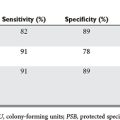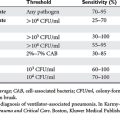CHAPTER 55 GENITOURINARY TRACT INJURY
KIDNEY INJURY
The most common indication of kidney injury on assessment in the emergency department is the presence of gross or microhematuria. Dipstick and urinalysis methods of determining the presence of hematuria have proved to be satisfactory for screening, with greater than 97.5% sensitivity and specificity,1 and should initiate the process of staging by radiographic evaluation. The presence of hematuria does not correlate with the degree of injury, however.
There is ongoing evidence that adult patients sustaining blunt trauma can be selectively imaged on the basis of presence of hematuria and hemodynamic status. Based on the large experience of McAninch and colleagues,1 as well as others, in working with patients with blunt trauma with microscopic hematuria and no evidence of shock, imaging is not required to assess urologic injury. Mee and colleagues2 studied 1007 patients with blunt trauma and found that patients with gross hematuria or microscopic hematuria (>5 red blood cells per high-powered field [RBCs/hpf]) and shock (SBP <90 mm Hg) are most likely to have significant injuries, and radiographic imaging is mandatory. The selection criteria to determine need for imaging is based on blood pressure findings recorded at any time during the patient’s initial evaluation, including paramedic assessment in the field.
These criteria do not apply to pediatric patients. The criteria for imaging in the pediatric population are different than for adults. This stems from the fact that there is not a well-established definition of shock in prepubertal children. Certainly, children with gross hematuria, regardless of hemodynamic stability, should be imaged. This will also allow for the detection of any congenital anomalies, such as ureteropelvic junction obstruction. Recent literature has been supportive of sparing imaging in stable children with only microhematuria. Brown et al.3 revealed only a 4.6% significant renal injury rate in children with blunt trauma and microhematuria, defined as more than 3 rbc/hpf. Using more than 50 rbc/hpf as a criterion for imaging children with blunt trauma, Morey et al.4 found only 1 in 147 patients with significant renal injury.
In addition, all patients with penetrating injuries and any degree of hematuria should be imaged or explored. At most major trauma centers, hemodynamically stable patients will undergo computed tomography (CT) scan of the abdomen and pelvis to rule out any abdominal injury. This incidentally allows visualization of the kidneys. The sensitivity and cost-effectiveness of the CT scan as a single imaging modality have for the most part replaced the routine use of IVP to exclude collecting system injury. Appropriate grading of renal injuries is crucial in determining management and expectant outcomes. The rate of urologic complications increases with increasing renal trauma grade. This can range from 0% complications with grade I injuries to 100% with grade V renal injuries. Performing follow-up CT scans in patients with grade III or higher injuries will detect 90% of delayed urologic complications.5
Blunt traumatic injuries as a result of automobile accidents, falls, or blows to the abdomen may cause significant damage to the kidney and represent at least 80% of all renal injuries seen in most urban hospitals. In rural hospitals, 90%–95% of kidney injuries are caused by blunt trauma. Bed rest and observation are successful in managing 95% of patients with blunt traumatic injuries. Santorelli et al.6 showed that solid organ injuries secondary to blunt trauma, including renal injury, can be managed nonoperatively in hemodynamically stable patients with approximately a 90% success rate. Urologic complications occur in about 11% of patients managed expectantly.7 These include delayed bleeding,8 post renal hypertension, arteriovenous fistula, and urinary extravasation.9 Similar findings are found in the pediatric population. Margenthaler et al.10 reported an 87% success rate with nonoperative management in pediatric blunt renal injury, including 26% of patients with high-grade injury. Only two of the seven children requiring surgery had failed conservative management. No patient with follow-up developed hypertension. The patient should be maintained on strict bed rest until gross hematuria has cleared, at which point ambulation should be allowed to a limited extent. The patient must be carefully monitored for hematocrit and evidence of retroperitoneal bleeding. If gross hematuria returns after ambulation is allowed, reassessment of the injury is indicated.
Penetrating injuries account for approximately 20% of renal injuries in urban settings. These injuries generally occur from gunshot wounds and stab wounds. All penetrating renal injuries require operative exploration, unless the staging process indicates that the renal injury is minor. Indications for renal exploration in patients with renal injury are excessive and persistent retroperitoneal bleeding, pulsatile retroperitoneal hematoma, urinary extravasation in the presence of other significant injuries, significant amount of nonviable tissue, and vascular injury. Clinical judgment must be exercised in applying these indications for operation. The risk of late complications, such as hematuria, arteriovenous fistula, scarring or renal hypertension, after conservative management, has been cited as a reason for prompt exploration. Velmahoes et al.11 evaluated the role of selective exploration of renal gunshot wounds and assessed the clinical and radiographic criteria of such a policy. Patients who underwent nephrectomy were more often hemodynamically unstable, had more severe kidney injuries, and had a higher Injury Severity Score (ISS) than patients who had renal reconstruction. In cases of renal exploration, proximal vascular control was practiced only in the presence of central injuries, provided that the patient was hemodynamically stable. This policy resulted in 38% of patients avoiding unnecessary renal exploration.
Grade IV renal injuries can be particularly challenging. Associated injuries are common, occurring in 80% of patients. These associated injuries are often the reason for laparotomy, with subsequent repair of the renal injury. In a patient who is hemodynamically stable after blunt injury, extravasation of urine would not necessitate renal exploration when additional indications for operation are not present. In fact, less than 10% of blunt traumatic renal injuries require exploration. A large retroperitoneal hematoma incidentally discovered during laparotomy calls for intraoperative excretory urography, which will give information regarding the injured kidney as well as whether the contralateral kidney is normal. If excretory urography reveals an abnormality, renal exploration is indicated. Carefully preoperative staging of the injury with use of CT (excretory urography optional) helps to identify patients who are candidates for nonoperative management. In the San Francisco experience of 113 grade IV renal injuries, 78% were explored, with only a 9% nephrectomy rate. Specific renal complications were rare (4%), with an overall complication rate of 23% in those patients managed conservatively. This was similar to those managed operatively, with a 4% renal complication rate, and an overall rate of 30%.12
The operative approach for exposure of an injured kidney is a transabdominal incision, which allows the surgeon to expose the renal vessels and control them with vessel loops. One of the main causes for total nephrectomy after trauma is uncontrollable renal bleeding. A retroperitoneal incision is made over the aorta just above the level of the inferior mesenteric artery. Dissection superiorly over the aorta should allow location of the left renal vein and both renal arteries. Applying vascular clamps to the individual vessel should control any massive bleeding if necessary. This method of control has been shown to significantly reduce nephrectomy.13 Reflecting the colon off the hematoma should adequately expose the kidney, and the hematoma can be entered without fear of exsanguinating hemorrhage. Repair of the injured kidney is successful in 90% of cases. Total nephrectomy secondary to trauma is seldom necessary.
URETERAL INJURY
The ureter or renal pelvis may be injured by a penetrating object (i.e., bullet or knife), surgical mishap, or blunt trauma. Blunt trauma is a rare cause, accounting for only 6% of ureteral injuries, and the other two types of injury occur approximately equally. Overall, ureteral injuries account for less than 1% of all genitourinary trauma. Patients with ureteral injuries from external trauma are often severely injured with multiple associated injuries. Diagnosis and management can often be challenging. Favorable outcomes are usually the result of early diagnosis and reconstruction. Failure to promptly recognize a ureteral injury frequently results in loss of functioning renal parenchyma, sepsis, and possibly death.14
In penetrating injuries of the ureter, microscopic hematuria is present in only 70%–80% of cases and should raise the suspicion for injury. On the other hand, there is a 30% false-negative rate.14 Imaging should be performed on any patient with an abdominal injury and any degree of hematuria, or those patients where the trajectory may raise suspicion of ureteral, or renal injury. CT scan or intravenous pyelogram (IVP) approach 90% diagnostic accuracy in the acute setting.15 Ureters that have been injured surgically and are unrecognized at the time, will often become obstructed and cause severe pain or prolonged ileus in the postoperative period. They may also present as excessive fluid drainage from surgical drain or wound. This fluid should be analyzed for creatinine. Excretory urography and retrograde ureterography can establish the diagnosis.
Penetrating injuries to the ureter require surgical reconstruction, in most cases by ureteroureterostomy, consisting of resection of the injured area and a primary repair. An exception of primary repair without debridement can be made in injuries resulting from blunt trauma or stab wounds. In all cases, internal stents using double-J catheters are recommended. In cases of surgical injury to the ureter that have been discovered within 2 weeks of operation, re-exploration and surgical management of the injury is recommended. Timing of diagnosis (early or late), location, grade of injury, and patient status should determine the type of management. Lower ureteral injuries may require ureteroneocystostomy, often with a psoas hitch. Mid- and upper-ureteral injuries can be managed by ureteroureterostomy or transureteroureterostomy. In all cases, adequate debridement of nonviable tissue, and a spatulated, mucosa-to-mucosa, tension-free anastomosis should be performed. Retroperitoneal drainage near the repair site is mandatory, and in some cases, use of omental flaps or other tissue should be used to further isolate the repair. Significant ureteral loss may require bowel interposition, autotransplantation, or nephrectomy.
BLADDER INJURY
Approximately 10% of pelvic fractures are associated with bladder rupture. On the other hand, about 85% of traumatic bladder injuries are associated with pelvic fracture. Gross hematuria is present in most cases (94%),16 and the remaining injuries will have microhematuria. The diagnosis is established by a traditional filling cystogram or CT cystogram. At least 400 ml of contrast medium should be used in either imaging study. Oblique and postvoid films should be performed with a fluoroscopic study. False-negative readings usually result from inadequate filling of the bladder with contrast. Injuries to the bladder are classified according to site of rupture. These sites, in decreasing order of frequency, are extraperitoneal (58%), intraperitoneal (∼33%), and combined (∼10%).
Patients who have intraperitoneal bladder rupture should undergo surgical exploration and repair of the bladder. A transabdominal mid-line incision in the lower abdomen can be used, and exposure of the bladder should be done at the mid-line. Lateral pelvic hematomas should be carefully avoided. The bladder should be opened at the mid-line and inspected from within. The length and number of lacerations cannot be assessed accurately by cystography. Any extraperitoneal lacerations are then closed from inside the bladder with a single layer of interrupted 2-0 or 3-0 absorbable suture. Intraperitoneal bladder rupture should be closed in two layers of running sutures. A suprapubic cystostomy tube may be left in place for 7–10 days, although modern experience has shown excellent success with urethral drainage alone. Parry et al. in a retrospective review, showed no difference in outcomes or complications in patients with bladder rupture treated with suprapubic tube and transurethral catheter versus transurethral catheter alone.17 A drain should be placed in the region of the repair. The bladder nearly always returns to full function. During the early healing phases, the patient should be monitored carefully for potential urinary infection. Radiographic studies are seldom indicated unless the patient has complications.
URETHRAL INJURY
Approximately 5%–10% of pelvic fractures are associated with urethral injury, usually at the proximal bulbar urethra. In addition, straddle injuries occur to the deep bulbar urethra and pendulous (anterior) urethra. These occur by forceful contact of the perineum with a blunt object such as handlebars or a fence. Another cause of blunt urethral trauma occurs in association with penile fracture. The incidence is about 20% in that situation. The most common indication of urethral injury is the finding of blood at the urethral meatus on initial examination, found in ∼75% of patients. Other findings include hematuria, although nonspecific; inability to void; and perineal or penile hematoma. Passage of a urethral catheter is contraindicated when urethral injury is suspected. Urethrography is recommended as the first study done and the presence of extravasation will establish the diagnosis. This should ideally be performed with the patient in an oblique position. With widespread use of CT as the frontline imaging modality for the acutely traumatized patient, it may be essential to be familiar with CT findings suggestive of urethral injury. Extravasation of contrast above the urogenital diaphragm (UGD) is consistent with prostatic urethral disruption. Extravasation below the urogenital diaphragm is more consistent with bulbar urethral disruption. There may also be a combination above and below this muscle plane, indicting a more extensive injury of the posterior urethra. Other nonspecific findings include obscuring of the UGD fat plane, hematoma near the ischiocavernosus muscle, and distortion of the prostatic contour or bulbocavernosus muscle.18
Virtually all urethral injuries are the result of blunt trauma (motor vehicle accidents, falls, or blows) and occur in men. When penetrating injuries are seen, operative exploration and reconstruction of the specific injury are generally indicated. The urethral injury is often concomitant with injury of the corpora cavernosa. These injuries can be repaired simultaneously. Exceptions to this rule are when the following findings are associated with the urethral injury: hemodynamic instability, multiple associated injuries of nongenital organs, or a large urethral defect. In these situations, placement of a suprapubic cystostomy tube should be the initial management. Female urethral injuries are uncommon (0%–6.0% of female patients with pelvic fracture).19
The initial management of blunt traumatic anterior urethral disruption has traditionally been placement of suprapubic cystostomy tube. This is usually done percutaneously, or can be done by open exploration of the bladder if exploratory laparotomy is to be performed for other injuries. Only a small cystostomy incision is needed to permit inspection of the inside of the bladder for any potential associated rupture, as well as placement of the suprapubic catheter. Manipulation of the deep pelvis should be avoided, and no drains should be left in place; these measures can introduce infection in a perivesical hematoma. There is recent controversy with management by immediate urethral realignment. This is a reasonable option in patients with penetrating injuries to the urethra, or blunt injuries associated with pelvic fracture, that do not have the other findings described earlier. The stricture rate is significantly less with immediate realignment, and fewer subsequent procedures are required. When performed in select patients, the incidence of impotence and incontinence is also less than in patients undergoing delayed reconstruction.20
Patients with complete prostatomembranous urethral disruption invariably develop a stricture at the site of the disruption, but this can be repaired electively 2–3 months after injury. This repair can be accomplished by a combined transpubic perineal approach, by endoscopic urethrotomy, or more commonly, by perineal urethroplasty. Adequate planning of the reconstruction should include imaging by traditional retrograde urethrogram or urethral ultrasonography. Twenty to 30% of patients with pelvic fractures may become impotent. This is believed to be caused by nerve and vascular damage at the time of injury, which has been shown arteriographically.21 Secondary stricture formation after urethroplasty may occur in 15%–20% of cases and often can be managed by endoscopic urethrotomy.
Patients with anterior urethral injury (bulbar and pendulous) who are managed by initial suprapubic cystostomy should have voiding cystourethrography approximately 2–3 weeks after injury; if no extravasation is noted, the patient should be allowed to continue voiding per urethra. Most of these patients develop relative strictures in the area of injury, but most do not require operative intervention or reconstruction. If operative correction is indicated, endoscopic urethrotomy is usually successful.
1 Chandhoke P, McAninch JW. Detection and significance of microscopic hematuria in patients with blunt renal trauma. J Urol. 1988;140:16-18.
2 Mee SL, McAninch JW, Robinson AL, et al. Radiographic assessment of renal trauma: a 10-year prospective study of patient selection. J Urol. 1989;141:1095-1098.
3 Brown SL, Haas CH, Dinchman KH, et al. Radiologic evaluation of pediatric blunt renal trauma in patients with microscopic hematuria. World J Surg. 2001;25:1557-1560.
4 Morey AF, Bruce JE, McAninch JW. Efficacy of radiographic imaging in pediatric blunt trauma. J Urol. 1996;156:2014-2018.
5 Blankenship JC, Gavant ML, Cox EC, et al. Importance of delayed imaging for blunt renal trauma. World J Surg. 2001;25:1561-1564.
6 Santorelli KH, Frumiento C, Rogers FB, et al. Nonoperative management of hepatic, splenic, and renal injuries in adults with multiple injuries. J Trauma. 2000;49:56-61.
7 Hershorn S, Radonski SB, Shoskes DA, et al. Evaluation and treatment of blunt renal trauma. J Urol. 1991;146:274-277.
8 Wein AJ, Murphy JJ, Mulholland SG, et al. A conservative approach to the management of blunt renal trauma. J Urol. 1977;117:425-427.
9 Carroll PR, Klosterman PW, McAninch JW. Surgical management of renal trauma: analysis of risk factors, technique and outcome. J Trauma. 1988;28:1071-1074.
10 Margenthaler JA, Weber TR, Keller MS. Blunt renal trauma in children: experience with conservative management at a pediatric trauma center. J Trauma. 2002;52:928-932.
11 Velmahoes GC, Demetriades D, Cornwell EE, et al. Selective management of renal gunshot wounds. Br J Surg. 1998;85:1121-1124.
12 Santucci RA, McAninch JW. Grade IV renal injuries: evaluation, treatment and outcome. World J Surg. 2001;25:1565-1572.
13 McAninch JW, Carroll PR. Renal trauma: kidney preservation through improved vascular control—a refined approach. J Trauma. 1982;22:285-288.
14 Presti JC, Carroll PR, McAninch JW. Ureteral and renal pelvic injuries from external trauma: diagnosis and management. J Trauma. 1989;29:370-374.
15 Carver BS, Bozeman CB, Venable DD. Ureteral injury due to penetrating trauma. South Med J. 2004;97:462-464.
16 Hsieh CH, Chen RJ, Fang JF, et al. Diagnosis and management of bladder injury by trauma surgeons. Am J Surg. 2002;184:143-147.
17 Parry NG, Rozycki GS, Feliciano DV, et al. Traumatic rupture of the urinary bladder: is the suprapubic tube necessary? J Trauma. 2003;54:431-436.
18 Ali M, Safried Y, Solafani S, Schulze R. CT signs of urethral injury. Radiographics. 2003;23:951-963.
19 Chapple C, Barbagli G, Mundy AR, et al. Consensus statement on urethral trauma. BJU Int. 2004;93:1195-1202.
20 Mouraview VB, Coburn M, Santucci RA. The treatment of posterior urethral disruption associated with pelvic fractures: comparative experience of early realignment versus delayed urethroplasty. J Urol. 2005;173:873-876.
21 Levine FJ, Greenfield AJ, Goldstein I. Arteriographically determined occlusive disease within hypogastric-cavernous bed in impotent patients following blunt perineal and pelvic trauma. J Urol. 1990;144:1147-1153.







